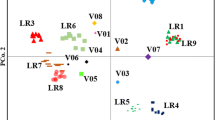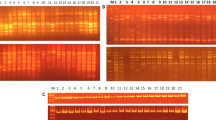Abstract
Genetic variability and relationships in 54 genotypes belonging to nine Gladiolus cultivars were determined using single primer amplification reaction methods (Random Amplified Polymorphic DNA—RAPD; Directed Amplification of Minisatellite DNA—DAMD; and Inter Simple Sequence Repeats—ISSR). A total of 30 primers (10-RAPD, 10-DAMD and 10-ISSR) resulted into 230 DNA fragments, of which 177 (75.8 %) were polymorphic in nature. The polymorphic information content (PIC = 0.18), resolving power (RP = 11.2) and marker index (MI = 11.4) was found to be highest in ISSR markers. To understand the extent of genetic variability among the Gladiolus cultivars, the cumulative dataset were used to generate UPGMA dendrogram. All the 54 genotypes clustered together in nine broad clusters, revealing that the clustering pattern of the genotypes were as per their cultivars. PCoA analyses also revealed similar clustering patterns along the axis and therefore corroborating the grouping of genotypes in UPGMA dendrogram. The STRUCTURE analysis showed the admixture of alleles and resulted into eight genetic populations. The present study demonstrates the efficiency and discriminatory potential of an individual as well as cumulative analysis of RAPD, DAMD and ISSR markers to estimate the genetic variability and inter-relationships among indigenously developed Gladiolus cultivars. Furthermore, documentation and preservation of genetically diverse Gladiolus germplasm could be an important source for improvement of this floricultural crop.




Similar content being viewed by others
References
Baydar NG, Baydar H, Debener T. Analysis of genetic relationships among Rosa damascena plants grown in Turkey by using AFLP and microsatellite markers. J Biotechnol. 2004;111:263–7.
Bose TK, Yadav LP, Pat P, Parthasarathy VA, Das P. Commercial flowers, vol. II. Kolkata: Naya Udyog; 2003.
Botstein D, White RL, Skolnick M, Davis RW. Construction of a genetic linkage map in man using restriction fragment length polymorphism. Am J Hum Genet. 1980;32:314–31.
Dallavalle E, D’Aulerio AZ, Verardi E, Bertaccini A. Detection of RAPD polymorphisms in Gladiolus cultivars with differing sensitivities to Fusarium oxysporum f. sp. Gladioli. Plant Mol Biol Rep. 2002;20:1–6.
Doyle JJ, Doyle JL. Isolation of plant DNA from fresh tissue. Focus. 1990;12:13–5.
Evanno G, Regnaut S, Goudet J. Detecting the number of clusters of individuals using the software STRUCTURE: a simulation study. Mol Ecol. 2005;14:2611–20.
Goldblatt P, Manning JC. Systematics of the southern African genus Ixia (Iridaceae). The I. rapunculoides complex. Bothalia. 2008;38:1–23.
Goldblatt P, Manning JC, Bernhardt P. Radiation of pollination systems in Gladiolus (Iridaceae: Crocoideae) in southern Africa. Ann Missouri Bot Gard. 2001;88:713–34.
Heath DD, Iwana GK, Delvin RH. PCR primed with VNTR core sequences yields species specific patterns and hypervariable probes. Nucl Acids Res. 1993;21:5782–5.
Hu J-B, Li J-W, Wang L-J, Liu L-J, Si S-W. Utilization of a set of high-polymorphism DAMD markers for genetic analysis of a cucumber germplasm collection. Acta Physiol Plant. 2011;33:227–31.
Hubisz M, Falush D, Stephens M, Pritchard J. Inferring weak population structure with the assistance of sample group information. Mol Ecol Resour. 2009;9:1322–32.
Jingang W, Hongkun J, Shufang G, Daidi C. RAPD Analysis of 12 general species of Gladiolus hybridus Hort. J Northeast Agric Univ. 2006;13:112–5.
Jingang W, Ying G, Daidi C, Shenkui L, Chuanpin Y. ISSR analysis of 26 general species of Gladiolus hybridus Hort. J Northeast Agric Univ. 2008;15:6–10.
Kolavalli S, Atheeq LK, Jacob X. Floriculture industry in India. New Delhi: Oxford and IBH Publication Company Limited; 1991.
Kumar A, Mishra P, Singh SC, Sundarsesan V. ISSR and RAPD markers in genetic divergence analysis and conservation management of Justicia adhatoda L., a medicinal plant. Plant Syst Evol. 2014;300:1409–20.
Kumar R, Yadav DS. Evaluation of Gladiolous Cultivars under sub-tropical Hill of Meghalaya. J Ornamental Hortic. 2005;8:86–90.
Lamare A, Rao SA. Efficacy of RAPD, ISSR and DAMD markers in assessment of genetic variability and population structure of wild Musa acuminate colla. Physiol Mol Biol Plants. 2015;21:349–58.
Mahar KS, Rana TS, Ranade SA, Pande V, Palni LMS. Estimation of genetic variability and population structure in Sapindus trifoliatus L., using DNA fingerprinting methods. Trees Struct Funct. 2013;27:85–96.
Mandel JR, Dechaine JM, Marek LF, Burke JM. Genetic diversity and population structure in cultivated sunflower and a comparison to its wild progenitor, Helianthus annuus L. Theor Appl Genet. 2011;123:693–704.
Mantel N. The detection of disease clustering and a generalized regression approach. Cancer Res. 1967;27:209–20.
Narzary D, Rana TS, Ranade SA. Genetic diversity in inter-simple sequence repeat profiles across natural populations of Indian pomegranate (Punica granatum L.). Plant Biol. 2010;12:806–13.
Nasir IA, Jamal A, Rahman Z, Husnain T. Molecular analyses of Gladiolus lines with improved resistance against fusarium wilt. Pak J Bot. 2012;44:73–9.
Pavlicek A, Hrda S, Flegr J. FreeTree—freeware program for construction of phylogenetic trees on the basis of distance data and bootstrapping/jackknife analysis of the tree robustness. Application in the RAPD analysis of the genus Frenkelia. Folia Biol (Praha). 1999;45:97–9.
Peakall R, Smouse PE. GenAlEx 6.5: genetic analysis in Excel. Population genetic software for teaching and research—an update. Bioinformatics. 2012;28:2537–9.
Powell W, Morgante M, Andre C, Hanafey M, Vogel J, Tingey S, Rafalski A. The comparison of RFLP, RAPD, AFLP and SSR (microsatellite) markers for germplasm analysis. Mol Breed. 1996;2:225–38.
Pragya Bhat KV, Misra RL, Ranjan JK. Analysis of diversity and relationships among Gladiolus cultivars using morphological and RAPD markers. Ind J Agric Sci. 2010;80(9):766–72.
Pritchard JK, Stephens M, Donnelly P. Inference of population structure using multilocus genotype data. Genetics. 2000;155:945–59.
Provost A, Wilkinson MJ. A new system of comparing PCR primers applied to ISSR fingerprinting of potato cultivars. Theor Appl Genet. 1999;98:107–12.
Ranjan P, Bhat KV, Misra RL, Singh SK, Ranjan JK. Genetic relationships of Gladiolus cultivars inferred from fluorescence based AFLP markers. Sci Hortic. 2010;123:562–7.
Raycheva T, Stoyanov K, Denev I. Genetic diversity and molecular taxonomy study of three genera from Iridaceae family in the Bulgarian flora based on ISSR markers. Biotech Equip. 2011;25:2484–8.
Rohlf FJ NTSYS-pc: numerical taxonomy and multivariate analysis system. Version 2.02e. (Exeter Software Setauket, New York); 1998.
Scariot V, de Keyser E, Handa T, de Riek J. Comparative study of the discriminating capacity and effectiveness of AFLP, STMS and EST markers in assessing genetic relationships among evergreen azaleas. Plant Breed. 2007;126:207–12.
Takatsu Y, Miyamoto M, Inoue E, Yamada Y, Manabe T, Kasumi M, Hayashi M, Sakuma F, Marubashi W, Niwa M. Interspecific hybridization among wild Gladiolus species of south Africa based on randomly amplified polymorphic DNA markers. Sci Hortic. 2001;91:339–48.
Verma S, Rana TS, Ranade SA. Genetic variations and clustering in Murraya paniculata, revealed by single primer amplification reaction (SPAR) methods. Curr Sci. 2009;96:1210–6.
Vos P, Hogers R, Bleeker M, Reijans M, van de Lee T, Hornes M, Frijters A, Pot J, Peleman J, Kuiper M, Zabeau M. AFLP: a new concept for DNA fingerprinting. Nucl Acids Res. 1995;21:4407–14.
Williams JGK, Kubelik AR, Livak KJ, Rafalski JA, Tingey SV. DNA polymorphism amplified by arbitrary primers are useful as genetic markers. Nucl Acids Res. 1990;18:6531–5.
Zhou Z, Bebeli PJ, Somers DJ, Gustafson JP. Direct amplification of minisatellite-region DNA with VNTR core sequences in the genus Oryza. Theor Appl Genet. 1997;95:942–9.
Zietkiewicz E, Rafalski A, Labuda D. Genome fingerprinting by simple sequence repeat (SSR)-anchored polymerase chain reaction amplification. Genomics. 1994;20:176–83.
Acknowledgments
This work was financially supported by the Council of Scientific and Industrial Research, New Delhi under the Grant BSC0110 (AGTEC). The authors would like to thank Director, CSIR-National Botanical Research Institute, Lucknow (India) for facilities and encouragements.
Author information
Authors and Affiliations
Corresponding author
Ethics declarations
Conflict of interest
No author has any possible conflict of interest.
Rights and permissions
About this article
Cite this article
Singh, N., Pal, A.K., Roy, R.K. et al. Assessment of genetic variation and population structure in Indian Gladiolus cultivars inferred from molecular markers. Nucleus 59, 235–244 (2016). https://doi.org/10.1007/s13237-016-0181-4
Received:
Accepted:
Published:
Issue Date:
DOI: https://doi.org/10.1007/s13237-016-0181-4




